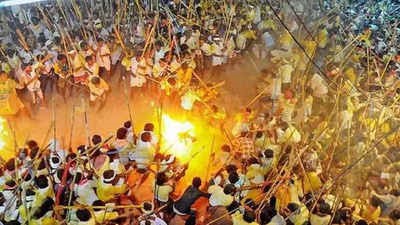
Banni festival

28.10.2023
Banni festival , Daily Current Affairs , RACE IAS : Best IAS Coaching in Lucknow
|
For Prelims: Banni festival,Rituals,Vijayanagara Empire(Governance,Inscriptions)Geography of Andhra Pradesh(Rivers of Andhra Pradesh,Wildlife and Bird Sanctuaries of AndhraPradesh) |
Why in the news?
Recently, three people lost their lives and more than a hundred were injured in the traditional Banni festival at Devaragattu in Kurnool district, Andhra Pradesh
About the Banni festival:
- It is an unusual festival celebrated in Andhra Pradesh.
- Banni actually refers to a mock fight for capturing the idols during the Banni festival.
- It is a traditional stick-fight.
- It is celebrated on the night of Dussehra celebration (Vijaya Dasami) every year.
- The objective of this event was to snatch the idols from God's team, leading to a fierce battle known as the Banni Fight.
- This festival was celebrated by people under the Vijayanagara Empire.
- It is celebrated on account of the victory of Lord Mala Malleswara Swamy and Goddess Parvati over demonish Mani and Mallasura, who troubled the people in the Devaragattu region.
- The Supreme Court had put a ban on this festival in 2008, but the ritual has continued to be held over the years.
Rituals
- The ritual takes place at midnight when the procession of idols of the ruling deities Malamma (Parvati) and Malleshwara Swamy (Shiva) are brought down the hill temple at Neraneki.
- Devotees carry long sticks or lathis with them for hitting each other with these sticks on the head.
- The basic idea of this fight is to capture the procession idol.
About Vijayanagara Empire:
- The Vijayanagara Empire, also called Karnata Kingdom, was based in the Deccan Plateau region in South India.
- It was established in 1336 by the brothers Harihara I and Bukka Raya I of the Sangama dynasty, members of a pastoralist cowherd community that claimed Yadava lineage.
Governance:
- The rulers of the Vijayanagara Empire maintained the administrative methods developed by their predecessors, the Hoysala, Kakatiya and Pandya kingdoms.
- The King, ministry, territory, fort, treasury, military, and ally formed the seven critical elements that influenced every aspect of governance.
- The King was the ultimate authority, assisted by a cabinet of ministers (Pradhana) headed by the prime minister (Mahapradhana).
- Other important titles recorded were the chief secretary (Karyakartha or Rayaswami) and the imperial officers (Adhikari).
- All high-ranking ministers and officers were required to have military training.
- A secretariat near the king’s palace employed scribes and officers to maintain records made official by using a wax seal imprinted with the ring of the king.
Inscriptions:
- Bitragunta inscription is the major source for construction of family history of sangama dynasty.
- Srirangam copper plates of Devaraya II provide the genealogy and achievements of Vijayanagar rulers.
- Various copper plate inscriptions of krishnadevraya time.
- The Hampi ruins and other monuments of Vijayanagar provide information on the cultural contributions of the Vijayanagar rulers.
Geography of Andhra Pradesh
- It has three physiological regions: the coastal plains, the mountain ranges, and the plateau.
- It is situated near the Bay of Bengal at 12°41' and 22°N latitude and 77° and 84°40'E longitude.
- It shares its border with Tamil Nadu in the south, Karnataka in the west, Chattisgarh & Maharashtra in the north and Orissa in the north-east. On its east, the Bay of Bengal renders the cool breeze to this state.
- The state is rich in fauna due to its richness of forests and water resources.
- The primary source of the state’s economy is Agriculture and rice is the main crop of agricultural products.
- Due to the high production of rice in Andhra Pradesh, it is also known as the rice bowl of India.
Rivers of Andhra Pradesh
- Krishna, Godavari and Pennar are the major rivers of Andhra Pradesh along with several smaller rivers and water resources of the state.
- Godavari is the second largest river of India after Ganges.
- Krishna River with a length of around 1300 Km, is the third largest river in central- southern India.
Wildlife and Bird Sanctuaries
- Nagarjunsagar-Srisailam Tiger reserve (India’s largest Tiger Reserve).
- Pulicat Lake Bird Sanctuary (India’s second-largest lagoon; Largest is Chilka).
- Nelapattu Bird Sanctuary
- Kondakarla Bird Sanctuary
- Coringa Wildlife Sanctuary (Mangrove forests)
- Krishna Wildlife Sanctuary.
- Atapaka Bird Sanctuary – Kolleru Lake
- Kolleru Wildlife Sanctuary.
Source:The Hindu